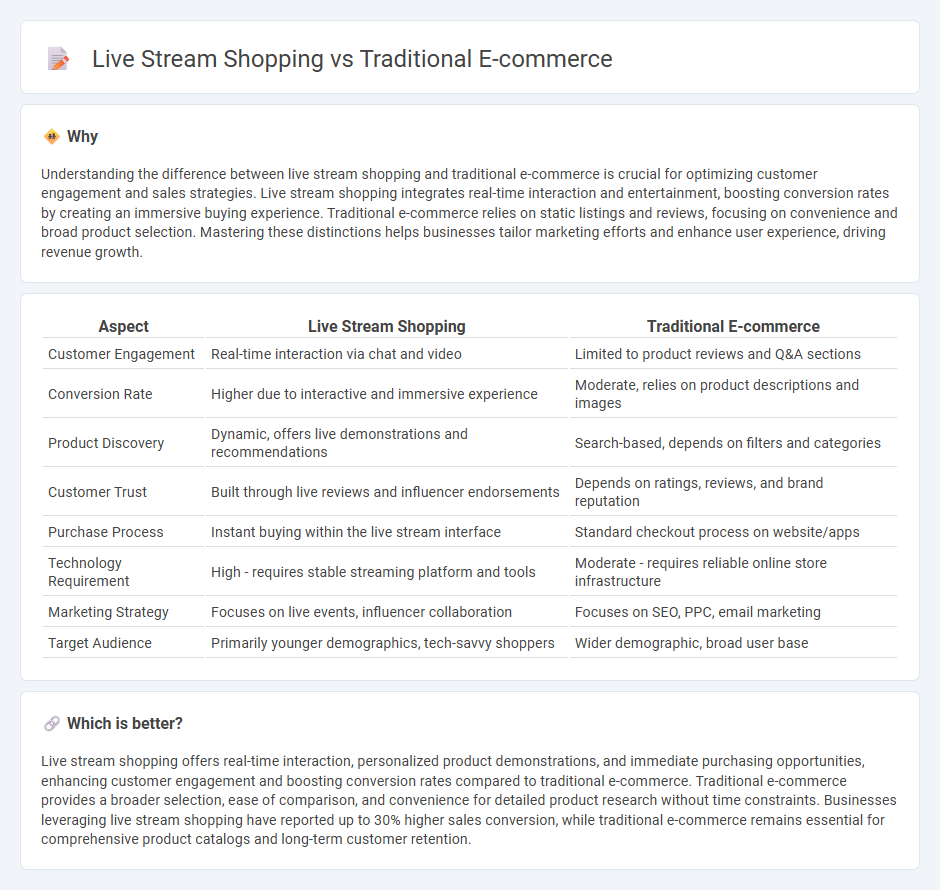
Live stream shopping merges real-time interaction with direct product showcasing, creating an immersive purchasing experience that contrasts with traditional e-commerce's static browsing model. This dynamic approach drives higher engagement rates and instant decision-making by leveraging influencer charisma and spontaneous promotions. Discover how integrating live stream shopping can revolutionize your sales strategy today.
Why it is important
Understanding the difference between live stream shopping and traditional e-commerce is crucial for optimizing customer engagement and sales strategies. Live stream shopping integrates real-time interaction and entertainment, boosting conversion rates by creating an immersive buying experience. Traditional e-commerce relies on static listings and reviews, focusing on convenience and broad product selection. Mastering these distinctions helps businesses tailor marketing efforts and enhance user experience, driving revenue growth.
Comparison Table
| Aspect | Live Stream Shopping | Traditional E-commerce |
|---|---|---|
| Customer Engagement | Real-time interaction via chat and video | Limited to product reviews and Q&A sections |
| Conversion Rate | Higher due to interactive and immersive experience | Moderate, relies on product descriptions and images |
| Product Discovery | Dynamic, offers live demonstrations and recommendations | Search-based, depends on filters and categories |
| Customer Trust | Built through live reviews and influencer endorsements | Depends on ratings, reviews, and brand reputation |
| Purchase Process | Instant buying within the live stream interface | Standard checkout process on website/apps |
| Technology Requirement | High - requires stable streaming platform and tools | Moderate - requires reliable online store infrastructure |
| Marketing Strategy | Focuses on live events, influencer collaboration | Focuses on SEO, PPC, email marketing |
| Target Audience | Primarily younger demographics, tech-savvy shoppers | Wider demographic, broad user base |
Which is better?
Live stream shopping offers real-time interaction, personalized product demonstrations, and immediate purchasing opportunities, enhancing customer engagement and boosting conversion rates compared to traditional e-commerce. Traditional e-commerce provides a broader selection, ease of comparison, and convenience for detailed product research without time constraints. Businesses leveraging live stream shopping have reported up to 30% higher sales conversion, while traditional e-commerce remains essential for comprehensive product catalogs and long-term customer retention.
Connection
Live stream shopping integrates real-time interaction and entertainment within the traditional e-commerce framework, enhancing customer engagement and boosting conversion rates. By combining video content with instant purchasing options, it bridges the gap between browsing and buying, creating a dynamic shopping experience rooted in the familiar infrastructure of online retail. This fusion leverages data analytics and customer feedback from both models to optimize product recommendations and personalize marketing strategies effectively.
Key Terms
Transaction Method
Traditional e-commerce relies on static web pages and shopping carts for transactions, requiring customers to navigate product listings and complete purchases independently. Live stream shopping integrates real-time video interactions with instant purchase options, enhancing engagement and enabling impulse buys through direct product demonstrations. Discover how live stream shopping is revolutionizing buying experiences with its interactive transaction methods.
Customer Engagement
Traditional e-commerce relies heavily on static product listings and user reviews, which can limit real-time interaction and personalized customer engagement. Live stream shopping enhances customer engagement through direct interaction, instant feedback, and a sense of community, significantly increasing conversion rates and brand loyalty. Explore how live stream shopping transforms customer experiences and boosts sales in today's digital marketplace.
Real-Time Interaction
Traditional e-commerce relies on static product listings and delayed customer feedback, limiting immediate engagement between buyers and sellers. Live stream shopping enhances real-time interaction by enabling instant communication, personalized demonstrations, and immediate responses to viewer questions, significantly boosting user engagement and trust. Discover how real-time interaction transforms the shopping experience and drives higher conversion rates.
Source and External Links
Difference between Traditional Commerce and E-commerce - Traditional commerce involves manual transactions and physical buying or selling without internet, typically in markets or stores, whereas e-commerce conducts commercial transactions electronically via the internet, enabling faster, automated processes and remote shopping.
E-commerce vs Traditional commerce vs Social commerce - Next-Cart - Traditional commerce occurs at physical geographical locations where customers interact face-to-face with goods or services, unlike e-commerce which is conducted online allowing purchase via digital means and delivery, with social commerce further integrating sales on social networks.
The Battle of Traditional Commerce, E-Commerce Who Wins? - Traditional commerce is rooted in physical storefronts and personal relationships providing trust and personalized services, facing challenges in adapting to the digital era where e-commerce offers global reach, convenience, and technological innovation.
 dowidth.com
dowidth.com